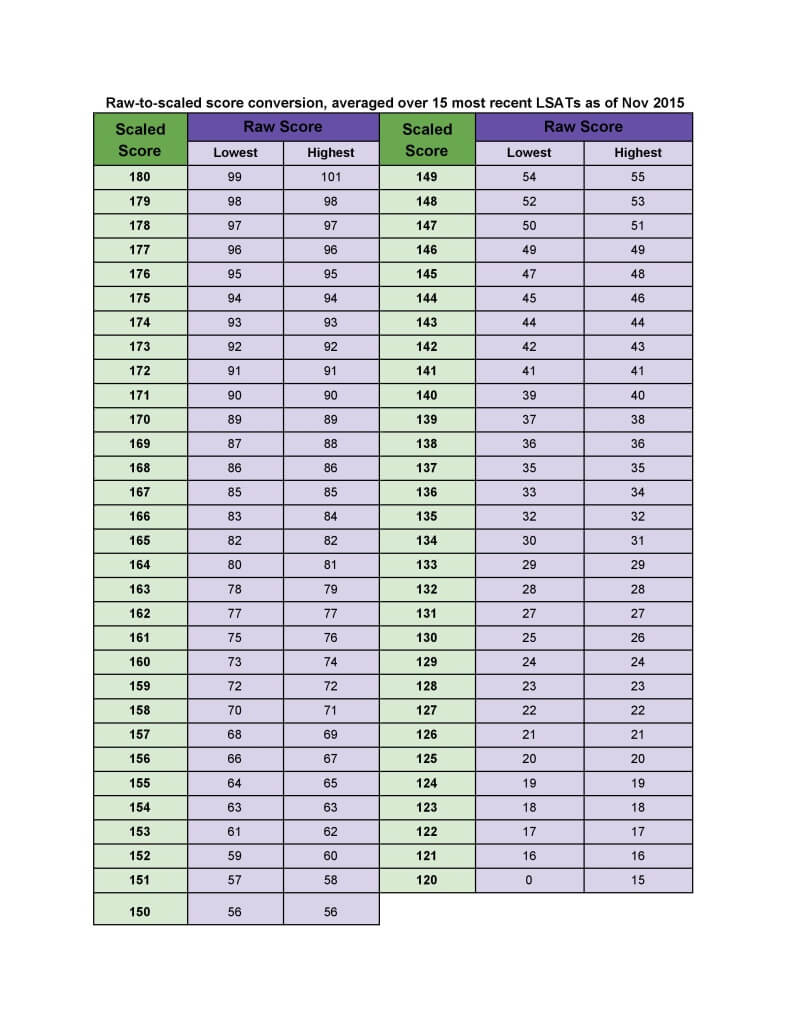You have 35 minutes to work on each section of the LSAT. I choose the words work on carefully because that conveys a very different meaning than saying you have 35 minutes to complete the section. The LSAT is a timed, standardized test. It is designed to be difficult for the vast majority of people to complete in the time allowed. Rather than focusing on answering every question, use a pacing strategy to set a reasonable goal for the number of questions you will attempt. Then, choose those questions wisely.
Playing with Numbers
A good pacing strategy starts with a clear goal for each section. If you haven’t figured out how many questions you need to answer correctly on the exam to hit your score goal, you can use the table below or read Setting LSAT Prep Goals for some guidance.

Once you know how many total questions you need to answer correctly to hit your goal, you can estimate how many right answers you’ll need in each section. Keep in mind, Reading Comprehension is the longest section and Logic Games is the shortest section, so you’ll want to adjust your numbers to account for that. Furthermore, you should adjust for your own strengths and weaknesses. For example, if Logical Reasoning is your strongest section, set a higher goal for that section.
Once you’ve got some solid numbers in mind for each section, here are some tips on where to find the points you need.
Reading Comprehension
There is one Reading Comprehension section on the LSAT. It contains 27 questions, divided into four sets. Three of the four sets pertain to individual passages. The remaining set (not necessarily the last one) pertains to a pair of related passages (these are called the Comparative Reading questions).
- If you’re aiming for more than 20 points in this section, you’ll need to attempt all four question sets.
- If you’re aiming for less than 20 points, you should at least consider guessing on all or part of one question set and spending more time on the other three.
- The passages and questions are in no particular order of difficulty, so you’ll have to assess them on your own and decide where to devote time and energy.
- Many people consider the Comparative Reading questions to be the most difficult, so that’s a common choice for those who guess on an entire set.
- Every question set has at least one or two tough ones. For most people, it’s beneficial to guess on or skip these the first time through. You can always return to them later.
- If you can’t eliminate at least 2 or 3 answer choices on your first attempt, you’re probably looking at a very difficult question. Consider moving on to easier questions.
Logic Games
There is one Logic Games (Analytical Reasoning) section on the LSAT. It contains 23 questions divided into four games. Each game will have 5-7 questions and will ask you to complete some central task according to a set of rules.
- If you’re aiming for more than 16 points in this section, you probably want to attempt all four games.
- If you’re aiming for 15 points or less, consider guessing on one entire game and spending more time on the other three.
- The games and questions are in no particular order of difficulty, so you’ll have to assess them on your own.
- There is usually at least one low difficulty game and at least one high difficulty game. Don’t waste time straining over a hard game if you haven’t completed the easy one yet.
- Sequencing and Fixed Grouping games are often lower level difficulty, whereas Floating Grouping, Matching, and Hybrid games are frequently more difficult.
- Even easy games have hard questions, and in Logic Games, hard questions can take up a lot of time. Consider guessing on these the first time through and only looking at them in detail if you have extra time at the end.
Logical Reasoning
There are two Logical Reasoning sections on the LSAT. They contain 25-26 questions each, and the questions stand alone or, occasionally, in pairs. Each question relates to a short paragraph of text immediately above it.
- LR questions can vary in difficulty throughout the section. However, there is a tendency for the questions to increase in difficulty as the section progresses.
- Many students struggle with particular types of Logical Reasoning questions. Learn the question types, play to your strengths, and avoid your weaknesses the first time through.
- LR questions can be tricky. It’s not uncommon to feel confident in an answer and later find out it was wrong. Combat this by answering a couple more questions than you think you need to.
- Remember that there are 2 LR sections, and they aren’t always equal in difficulty. You can adjust your goals for the second section depending on how the first one goes.
Some Final Considerations
Assess your testing style: if you move quickly but are prone to making mistakes, answer more questions than you think you need. If you move slowly but are very accurate, you can answer fewer questions and focus on getting them right.
And lastly, don’t expect your pacing strategy to work out the first time. It’s a new approach to test-taking, and it requires practice and refinement. Treat practice sections and practice tests like the real thing whenever possible. Time them and execute your pacing strategy. Keep track of what worked and what didn’t, and then make adjustments as necessary. Most importantly, give yourself credit for small gains, because successful LSAT prep is an accumulation of small gains rather than sudden, dramatic improvements.
If you have any pacing tips of your own that you think should be shared with the community, don’t hesitate to reach out with a comment.






Leave a Reply